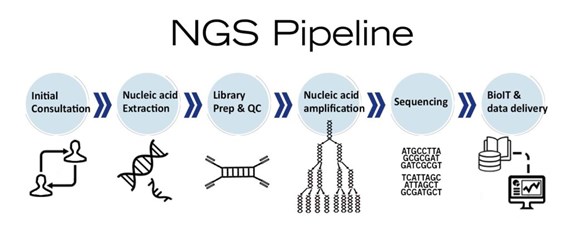Overview – What is the difference between de novo genome sequencing and genome re-sequencing?
Whole-genome sequencing (WGS) is the sequencing of all DNA present in the genome of an organism, including chromosomal DNA, mitochondrial DNA and chloroplast DNA if in plants. Two types of WGS approaches are available that mainly differ in their dependency on a reference genome sequence.
When a genome is investigated for the first time, the process of sequencing and genome assembly is called de novo sequencing. In this process, overlapping sequencing reads are assembled into longer fragments that are further pieced together until the entire sequence of the genome is decoded. This method enables genomic characterisation of newly discovered organisms, comparative analysis of highly variable genomes and in-depth exploration of structural variants.
In cases where a consensus sequence for a specific genome is already available, whole-genome re-sequencing can be applied. In this process, generated reads are directly aligned to the reference sequence. This comparative sequencing enables identification of single-nucleotide polymorphisms (SNPs), insertions-deletions (InDels) and structural variations between organisms. The detailed genetic background of an individual is relevant for fields like plant and animal breeding, population genetics and clinical applications such as determining disease risk factors and discovering novel biomarkers for diseases diagnosis.

Applications – What are the advantages of genome re-sequencing and de novo genome sequencing?
Re-sequencing is particularly useful for:
- Comparing variations across multiple genomes
- Characterising variations like SNPs and InDels
- Detecting large structural variants like duplications, inversions, genomic rearrangements, copy number variations (CNV)
- Updating reference genome with newly identified mutations
- Genotyping
- Exploring genetic evolution
- Performing genome-wide association studies (GWAS)
De novo sequencing enables:
- Studies of the genetic make-up of newly discovered organisms
- Comparative analysis of genomes that are highly variable
- In-depth variant characterisation
Products related to de novo genome sequencing and genome re-sequencing
Do you want to be the first to sequence the genome of your organism of interest? Contact us.
Does the reference genome sequence of your model organism already exist? Then perform comparative analysis with our INVIEW Resequencing product and benefit from the combination of library preparation, sequencing and expert BioIT analysis to get top-quality sequencing data.
Did you know that we at Eurofins Genomics offer broad range of next generation sequencing products, such as the INVIEW Human Exome?